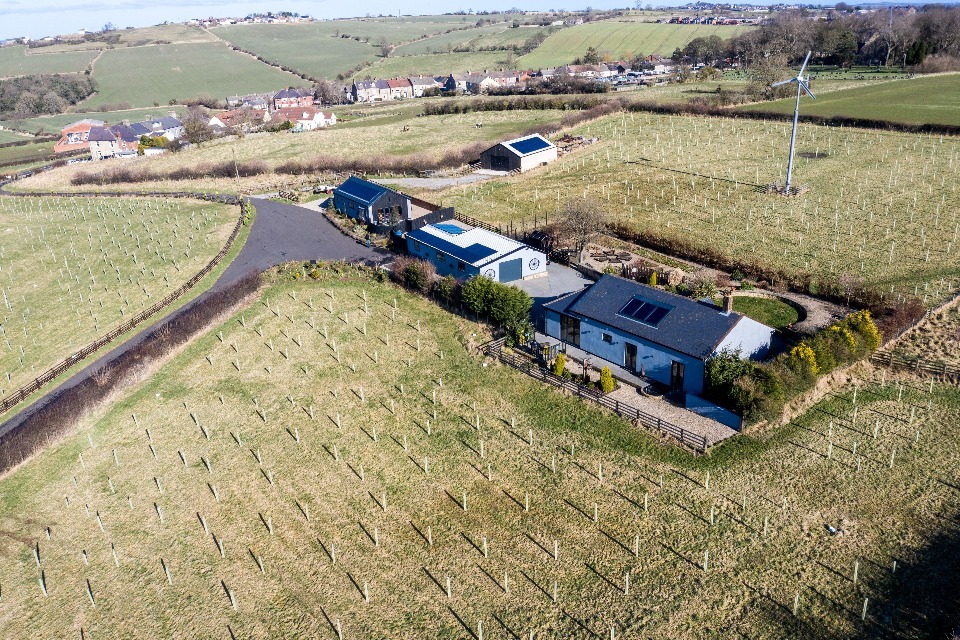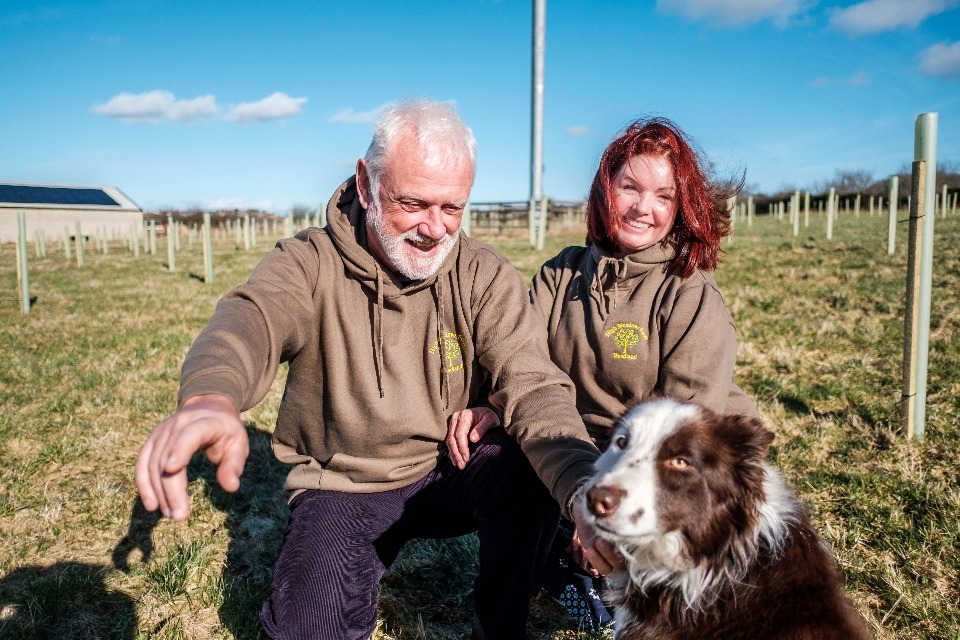High Meadows, County Durham
Updated 26 November 2025
Applies to England
High Meadows is a 20 hectare site near Bishop Auckland, in County Durham. Over the past 100 years, it has evolved from colliery to greyhound racing track, to farm, and is now in the process of becoming a woodland. The site is transforming the local landscape and contributing to the owners’ desire to tackle climate change, whilst aligning with their vision of a place that benefits nature, people and the planet.
Key facts
- site: High Meadows Farm, County Durham
- size: 14 hectares of new woodland
- type: mixed broadleaf with conifer edges
- species: 14 broadleaf species including hazel, hawthorn, alder, oak, aspen and willow
- date planted: January 2021
- grants: Woodland Creation Planning Grant (WCPG) and the England Woodland Creation Offer (EWCO)
- key objective: to enhance the local landscape, increase biodiversity, and provide recreational space for the local community
A need for change
Terry and Tracy Featherstone took over the family farm at High Meadows in 2015. The former village greyhound racing track had been bought by Terry’s parents in the 1960s and was converted into a 20 hectare farm, grazed by sheep and cattle.
Terry and Tracy kept some of the sheep but felt that with the significant effort required to manage them and little financial gain, a change in land use was needed. They were also becoming increasingly concerned with the impact of climate change and recognised this as their opportunity to create a legacy that would help mitigate its effects.

Aerial view of planting at High Meadows Farm
Financially supported woodland creation
Their journey towards a more environmentally sustainable way of living began in earnest with a home renovation project that incorporated two ground-sourced heat pumps, solar panels, a 12kW wind turbine and 65kW storage batteries. This enabled them to be mostly self-sufficient and to earn money by selling energy back to the grid.
Then, at an event held by the National Farmers’ Union, Terry met local Forestry Commission staff and began to consider woodland as an alternative land use option. A successful application for the Woodland Creation Planning Grant (WCPG) helped to cover the costs for scoping and designing the new woodland, which then proceeded into an application to the England Woodland Creation Offer (EWCO) grant scheme.
Terry Featherstone, owner, High Meadows:
We knew we couldn’t keep sheep forever, and we thought ‘if we do it properly, we can just grow old and watch these trees grow’. Now [with] the beauty, the variety, the birdlife… it’s [been] an absolute joy.
This covered the costs of establishing the new woodland as well as 15 years of annual payments to support its maintenance. High Meadows also benefitted from additional stackable payments for its contributions to nature recovery and the local community because the owners granted access for people to enjoy a woodland walkway.

Terry and Tracy Featherstone with their dog at High Meadows Farm
The scheme was also registered with Forest Carbon who act as an intermediary and project developer for the Woodland Carbon Code (WCC). The carbon market provides an opportunity for landowners to generate capital or income from their land by selling the additional carbon that new woodlands will sequester. This woodland is predicted to capture 4,400 tonnes of carbon dioxide from the atmosphere over a 100-year period. Companies can invest in new woodlands certified under the WCC to offset future emissions and Forest Carbon has already been successful in finding buyers for all the carbon credits from High Meadows Wood.
Planting the woodland
Planting took place in January 2021, with 20,000 mixed broadleaf trees distributed across a site of 14 hectares by a local tree supplier. Terry and Tracy are managing their maintenance and future beat ups (a forestry term for the replacement of young trees which don’t survive).
To improve the genetic diversity of the woodland, a mix of species were carefully chosen to increase resilience to climate change, pests and diseases. The woodland integrates into the wider landscape of existing hedgerows and trees and within these areas, will improve the diversity in the age and size of trees to provide a wider variety of habitats for woodland species including insects and fungi.

Planting at High Meadows Farm
Top tips
- creating new woodlands can seem daunting at first, but the local Forestry Commission team can provide expert advice to guide you through the design and application process
- selling Woodland Carbon Code units now or in the future can provide valuable additional capital or income. If you would prefer not to do this yourself, you may wish to explore help from project developers or forest agents for the process of buying and selling carbon credits for new woodlands
- providing public access to your woodland can bring a range of community benefits and make your scheme eligible for EWCO Additional Contributions
Benefits for nature, people and the planet
Only three years after planting, and High Meadows is already bringing noticeable benefits to its owners, the environment and wider community. For Terry and Tracy, their new woodland is a ‘joy’. The trees are growing well with some already taller than Terry!
Nature recovery is well underway with a noticeable increase in the number and variety of insects and birds that have returned to the land. This includes swifts that have moved into their garage and two barn owls that will perch on tree guards and hunt for prey. Planting next to the existing pond and stream tributary to the River Gaunless has improved flood risk prevention, reduced boggy patches on their fields and enhanced the local environment for the benefit of the local community. The trees provide respite from the summer heat and in periods of wet weather, water no longer flows off their fields onto the local road.

Barn owl © Getty Images, iStock, Alan Walker
Terry and Tracy received EWCO Additional Contributions for granting recreational access to their woodland and planting close to settlements. Scientific studies have shown that forests can improve an individual’s physical, mental and social wellbeing. People are already using and enjoying the new woodland and public access has provided a shortcut between two neighbouring villages, improving connectivity between these communities.
Access will be further encouraged through the creation of walkways and benches in the next couple of years. Terry and Tracy also hope to engage young people in the scheme and encourage the next generation to care for trees and woodlands.
Find out more about how the Forestry Commission can help you create woodland.

